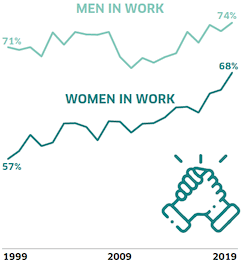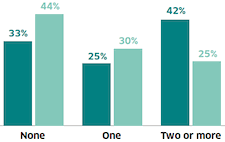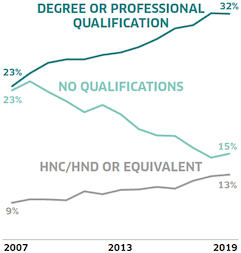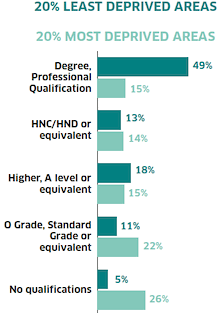Scottish household survey 2019: key findings
An infographic summary of the key findings from the 2019 edition of the Scottish Household Survey, a continuous survey running since 1999 based on a sample of the general population in private residences in Scotland.
Section Five - Economic Activity
In 2019, 56% of adults over the age of 16 were in employment in Scotland.
This number included those in full- and part-time employment and those who were self-employed. The proportion of adults in all these three categories had increased significantly between 1999 and 2019.
The proportion of adults that were not in the labour force decreased in this period, from 43% to 40%. Notably, the proportion of adults caring for their home and family decreased from 8% to 4%.
Additionally, the proportion of adults who were unemployed and looking for work decreased from 5% to 3%.

This line graph shows the proportion of people over 16 in the three main economic statuses (Employed, Not in Labour Force, and Unemployed), from 1999 or 2019. It highlights that the majority of people were employed and that there was an increasing proportion of people in this category, while the proportion of people not in the labour force had decreased slightly over time.
15% of adults who lived in social housing were permanently sick or disabled
The equivalent among private renters and owner occupiers was 3% and 1%, respectively
This represents the whole population and does not indicate unemployment rate.
The proportion of both men and women aged 16 to 64 who were in paid work had increased between 1999 and 2019.
This includes those who are in full- and part-time employment, and those who are self-employed.
The proportion of women aged 16 or older in work has increased significantly since 2016.
Women in households with children were more likely to be in work than those in households without children in 2018. However, in 2019 there was no difference between these groups as the proportion of women in work in households with children remained stable, while women in households without children increased by four percentage points.

This line graph shows the proportion of men and women aged 16 to 64 that were in paid employment, and how that changed between 1999 and 2019. It highlights that while there consistently was a larger proportion of men in paid work, the proportion of women in work had increased significantly since 1999.
Among women in a working age, the proportion who were looking after the home or family had decreased significantly from 18% in 1999 to 9% in 2019
In 2019, the proportion of households with adults (those aged 16 or over) in paid employment differed significantly across different levels of deprivation.
The reason a household might not have an adult in paid employment varies, and can for example be due to it being an older household, due to long-term illness or unemployment.
In the 20% most deprived areas, 44% of households did not have an adult in paid employment, and only 25% had two or more adults in paid employment.
In the 20% least deprived areas, 42% of households had at least two adults in paid employment.

This bar chart shows the proportion of households in the most and least deprived areas that had either none, one, or two or more adults in paid employment. It highlights that households in the most deprived areas tended to have one or no adults in paid employment, while a larger proportion of households in the least deprived areas had two or more adults in paid employment.
The proportion of households in the 20% most deprived areas with at least one adult in paid employment had increased
from 50% in 2013 to 56% in 2019
The graph relates to all households in Scotland.
In 2019, 32% of adults in Scotland had a degree or professional qualification.
This was a significant increase since 2007, when 23% of adults over 16 had a degree or professional qualification.
The proportion of people with a Higher National Certificate or Diploma (HNC/HND) or equivalent had also increased since 2007, from 9% to 13% of all adults over 16.
At the same time, the proportion of people with no qualifications had decreased from 23% in 2007 to 15% of all adults over 16 in 2019.

This line graph shows the proportion of adults in Scotland with different educational qualifications (Degree or Professional Qualifications, No Qualifications, and HNC/HND or Equivalent), and how this changed from 2007 to 2019. It highlights that there had been an increase in the proportion of adults with a degree or professional qualification, and a decrease in the proportion of people without qualifications.
Women were significantly more likely than men to have a degree or professional qualification
33% of women in Scotland had a degree or professional qualification, while the equivalent number for men was 31% of adults without any educational qualification were in paid work
This data has only been collected since 2007. The graph does not include adults with standard grades or Highers, as the proportion has not changed significantly.
Adults who lived in the 20% least deprived areas were significantly more likely to have a degree or professional qualification than adults in the 20% most deprived areas.
Half of all adults in the 20% least deprived areas had a degree or professional qualification. This was the most common educational qualification for this deprivation level.
Almost 3 in 10 adults in the 20% most deprived areas had no qualifications. This was the most common educational qualification for this deprivation level.

This bar chart shows the proportion of adults in the least and most deprived areas with a certain educational qualification, in the following order: “Degree or professional qualification”, “HNC/HND or equivalent”, “Higher, A level or equivalent”, “O Grade, standard grade or equivalent”, and “No qualifications”. It highlights that there were more adults in the most deprived areas without educational qualifications or with O grades, standard grades or equivalent being their highest educational qualification, while there were more adults with a degree or professional qualification in the least deprived areas.
46% of adults without any educational qualification were in paid work
This is significantly lower than those with a degree or professional qualification (80%) or with Higher or Standard grades (66%)
Contact
Email: shs@gov.scot
There is a problem
Thanks for your feedback